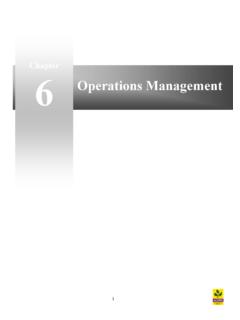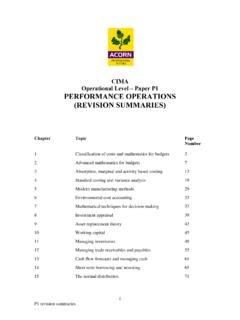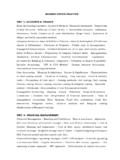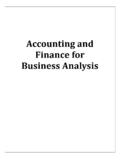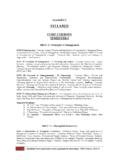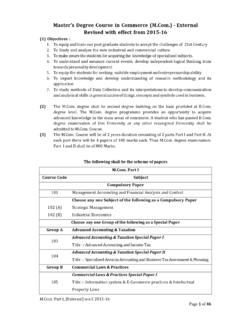Transcription of CIMA Operational Level Paper F1 FINANCIAL …
1 F1 revision summaries 1 CIMA Operational Level Paper F1 FINANCIAL operations ( revision summaries ) Chapter Title Page number 1 Regulatory framework 3 2 Format of FINANCIAL statements 9 3 Preparing FINANCIAL statements for single company 13 4 Cash flow statements for single company 15 5 Group accounts what is a group? 19 6 Group accounts consolidated statement of FINANCIAL position 21 7 Group accounts consolidated income statement 31 8 Associates 35 9 Reporting FINANCIAL performance IAS 1, IAS 8, IFRS 5, IFRS 8 and IAS 18 39 10 Non current tangible assets 47 11 Non current intangible assets 55 12 Inventories and construction contracts 59 13 Leasing 63 14 Various standards: (IAS 10, 37 and 24) 67 15 Share capital transactions and FINANCIAL instruments (IAS 32 & IAS 39) 73 16 External audits 81 17 Concepts, sources & systems in taxation 85 18 Tax depreciation losses & groups 87 19 Other areas of tax 91 20 International & deferred taxation F1 revision summaries 2 F1 revision summaries 3 The Regulatory Framework Chapter 1 F1 revision summaries 4 Key summary of chapter the regulatory framework Regulatory system for FINANCIAL statement production International Accounting Standard Board (IASB)
2 Regulatory system Company law Accounting standards Stock exchange rules EC directives GAAP Conceptual framework International Accounting Standards Board (IASB) - London Standard Advisory Council (SAC) International FINANCIAL Reporting Interpretations Committee (IFRIC) International Accounting Standards Committee Foundation (IASC Foundation) -USA F1 revision summaries 5 Accounting standards and the IASB The objectives of the IASB Develop a single set of accounting standards, which are of the highest quality and give users of the accounts transparency and comparability. To promote the use of these standards in the correct manner. To achieve convergence of national accounting standards all around the world Development of accounting standards 5 stages The conceptual framework The framework is a conceptual accounting framework that sets out the concepts that underlie the preparation and presentation of FINANCIAL statements for external users.
3 It was produced by the IASC and has been adopted by the IASB. It is not an accounting standard, and nothing in the framework overrides a specific international accounting standard. 1 Objectives of FINANCIAL statements 2 Underlying assumptions 3 Qualitative characteristics of FINANCIAL statements 4 Elements of FINANCIAL statements 5 Recognition of the elements of FINANCIAL statements 6 Measurement of the elements of FINANCIAL statements 7 Concept of capital and capital maintenance Developments in accounting harmonisation IASs and IFRS are used in many parts of the world. Many countries are converging their local GAAP with IASs / IFRSs. Often there is a time lag in adopting an IFRS as local GAAP. Convergence with US GAAP The largest capital market remaining with its own standards is the US.
4 The United States Securities and Exchange Commission (SEC) requires all overseas companies listed in the US to prepare their FINANCIAL statements using either US GAAP or their local GAAP but doing a reconciliation between their local GAAP and US GAAP. F1 revision summaries 6 Governance and social responsibility Governance is the system by which organisations are directed and controlled. Good governance would not only emphasise achieving the main purpose of the organisations, following the law and industry regulations but also being ethical, accountable, manage risks and have effective internal controls by employing experts. Social responsibility is the responsibilities that the organisation has to others outside of the direct owners.
5 These may include the environment, employees, customers, suppliers, government, pressure groups and the public at large. Ethics Ethics is the code of moral principles about what is right and wrong in an organisation. Ethics is a set of moral principles within employee or corporate culture and therefore culture plays a big part. Law does not necessarily enforce it nor do government organisations, and can relate to social responsibility Ethics for accountants Qualified professional accountants must act ethically to ensure that they are not acting illegally; ensure that reporting and professional standards are being met, the profession s reputation is protected and that they serve the public interest. Qualified accountants are governed by their professional bodies such as CIMA or ACCA and provide a code of ethics to which they need to comply.
6 Fundamental principles Integrity. Objectivity. Confidentiality. Professional behaviour. Professional competence and due care. Professional and technical standards. Personal qualities of accountants Reliability. Responsibility. Timelines. Courtesy. Respect. F1 revision summaries 7 Professional qualities of an accountant Independence in mind and appearance. Scepticism question information given. Accountability for your own judgements and decisions. Social responsibility - to the public, employer or clients. Personal development and lifelong learning Personal development is important for the accountant as these will make him a far better rounded professional. There should be development of interpersonal skills, writing skills, organisational skills, presentation skills, client management skills and relationship building skills.
7 Lifelong learning is also important as a professional accountant must be up to date with the latest techniques, skills and legislation to give better advice to the client. The CIMA and IFAC Codes of Ethics for Professional Accountants In 2005 CIMA launched their code of ethics designed to govern its members. It is the minimum standard expected of all members when carrying on their business in a professional and personal capacity. The code has three parts: Part A General Applications of the Code Part B Professional Accountants in Public Practice Part C Professional Accountants in Business In 2005 IFAC also launched its code of ethics and must be followed by all members of IFAC which includes CIMA. It overrides any codes created by national accountancy bodies and are more stringent.
8 CIMA s code of ethics fully complies with IFAC s code of ethics and bears a lot of similarity as CIMA had contributed heavily to IFAC's development of their code of ethics. F1 revision summaries 8 F1 revision summaries 9 Format of FINANCIAL Statements Chapter 2 F1 revision summaries 10 Key summary of Formats of FINANCIAL statements The objective of FINANCIAL statements is to provide information about the FINANCIAL position, FINANCIAL performance, and cash flows of an entity that is useful to a wide range of users in making economic decisions. The FINANCIAL statements of a company consists of Old titles New titles Income statement Statement of comprehensive income Balance sheet Statement of FINANCIAL position Cash flow statement Statement of cash flows Statement of changes in equity Statement of changes in equity Statement of comprehensive income (income statement) The statement of comprehensive income (income statement) shows all the income and expenses during the period for the organisation.
9 Income statements should help investors and other users determine the past performance of the organisation and help them to predict future performance. The revised IAS 1 (Sept 2007) allows 2 formats to be adopted showing all income and expenses. (1) In a single statement called Statement of comprehensive income : or (2) In two separate statements called ncome statement and statement of other comprehensive income . Items that normally appeared in the statement of changes in equity before IAS 1 was revised in 2007 will now be shown on the face of the comprehensive income statements as either part 1 or 2 formats detailed above. Expenses by function or nature IAS 1 allows two further formats for the income statement relating to how the expenses are analysed (function or nature).
10 This would relate to the income statement part in the statement of comprehensive income and to the separate statement income statement for the part 2 format detailed above. Expenses analysed by function are analysed according to their function, this includes cost of sales, administration or distribution activities. You will be more familiar with this. If the organisation categorises by function, additional information on the nature of expenses (depreciation, amortisation, wages etc) must be disclosed. Expenses analysed by nature, are not analysed by their function but by their nature, so for example purchase of goods, wages, depreciation. Dividends Dividends are shown the statement of changes in equity.


